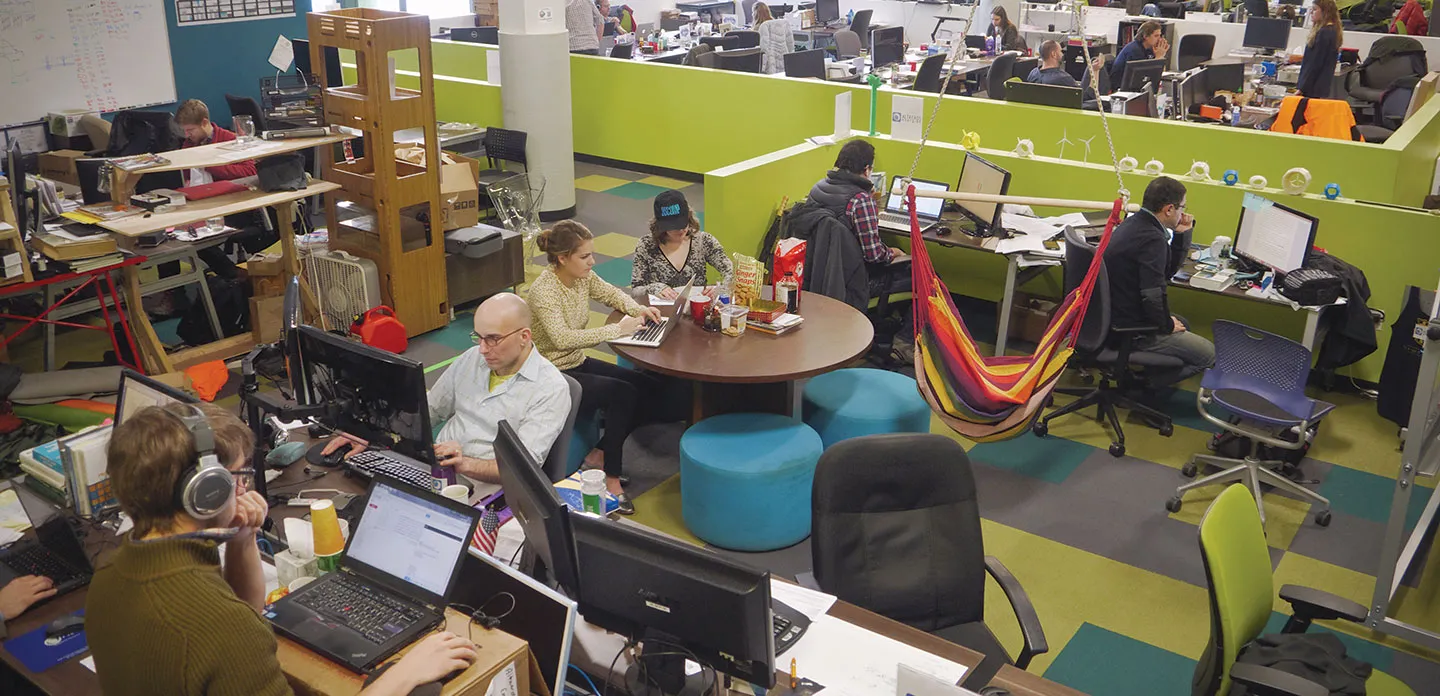What began as a loose affiliation of engineering students from the Massachusetts Institute of Technology (MIT), who banded together to share work space, has grown to become Greentown Labs, Inc., the leading business incubator for start-up companies working to solve energy and environmental challenges through clean technology development. The premise behind Greentown Labs is to share resources—including work space, machine shop equipment, and development solutions, so start-ups can develop technologies and build products without breaking the bank—as well as to become part of a development community that’s working on big energy problems.
Since its founding in 2011 with four participating startups, Greentown Labs has grown its role in the energy and clean technology ecosystem by holding regular EnergyBar networking events as well as educational events for entrepreneurs. To date, the incubator has served 76 start-up companies, with 41 currently working on clean technologies at the Greentown Labs site. Many of the incubator’s startups have built award-winning companies as part of a vibrant community of entrepreneurs, who are working on solving significant challenges.
While Greentown Labs enables participants to share the cost of office, machine shop, and event space, the incubator’s start-ups needed access to advanced design, simulation, and visualization solutions to speed technology R&D and commercial product development. According to Executive Vice President Mark Vasu, Greentown Labs surveyed its community to determine the design and engineering tools that they needed before standardizing on the SOLIDWORKS development platform.
“For the vast majority of our members, SOLIDWORKS is the design software that they used at nearby universities,” Vasu explains. “In addition to familiarity, we’ve found levels of loyalty, receptivity, and enthusiasm for the SOLIDWORKS design environment that is quite consistent. Our members truly depend on the software.”
Greentown Labs chose to make SOLIDWORKS solutions available to its member start-ups because it’s easy to use; is well known in the energy and clean technology community; and offers the full range of design and engineering applications required to accelerate development, prototyping, and manufacturing.
“SOLIDWORKS is hands-down what our members wanted to work with the most,” Vasu explains. “What’s particularly beneficial to our start-ups is that as the complexity of their problem-solving grows, they can tap into additional SOLIDWORKS solutions, such as simulation software, to overcome substantial challenges. We’ve also arranged a series of ‘lunch and learn’ webinar training sessions with CADD Edge, our SOLIDWORKS reseller, which has been quite successful. It’s pretty amazing how Greentown Labs members live, breathe, and rely on SOLIDWORKS.”
Capturing Sun’s Rays to Heat Water
Avalanche Energy, Inc. developed the SunTracer™, a patentpending solar hot water system that reduces energy bills and complements fossil fuel- and electric-powered water tanks, as a Greentown Labs member. Founder Alex Pina, previously a systems and prototyping engineer at the MIT Lincoln Laboratory, first had the idea for the system, which uses a suntracking parabolic dish to focus solar energy to produce hot water, while pondering ways to help his grandparents reduce their natural gas bills.
“I was thinking about a way to help my grandparents save money on their gas bill,” Pina recalls. “Their trailer couldn’t support solar panels, but it could handle a small dish, like those used for television and Internet service. There wasn’t anything on the market that met their needs, so I developed some small systems in SOLIDWORKS during my graduate work at MIT while earning a degree in engineering and management. As the idea gained traction, I decided to continue developing the model in SOLIDWORKS and use that model to build multiple prototypes.”
Pina heard about Greentown Labs while attending an EnergyBar event. “It made sense to take advantage of co-working space to accelerate development and move building of the system out of my apartment,” Pina says. “Being around other clean technology innovators, sharing the use of advanced hardware, and having access to the complete suite of SOLIDWORKS tools has really helped to speed up development and prototyping.”
Avalanche Energy relied on SOLIDWORKS Premium design tools to design the system and create photorealistic renderings to communicate the system concept to partners, investors, and prospective buyers. The company also utilized SOLIDWORKS thermal, flow, and structural analysis capabilities to validate and optimize the SunTracer design.
Initial field-testing of the system, including its two-axis solar tracking capability, occurred in 2014, with full system tests slated to take place in late 2015. Due to the SunTracer’s tracking capability, the system provides greater flexibility, and its lightweight design can be installed at half the cost of comparable systems. The SunTracer can be mounted on rooftops with various orientations. Because the dish follows the sun across the sky, it doesn’t have to be mounted on a south-facing structure. And it requires only an easy connection to an existing hot water tank.
“The ability to make quick design changes in SOLIDWORKS has really sped up development,” Pina stresses. “I can change one dimension and the change ripples throughout the assembly and updates all associated drawings. I don’t know how we would have gone about developing the SunTracer without SOLIDWORKS and the flexibility that it provided us.”
